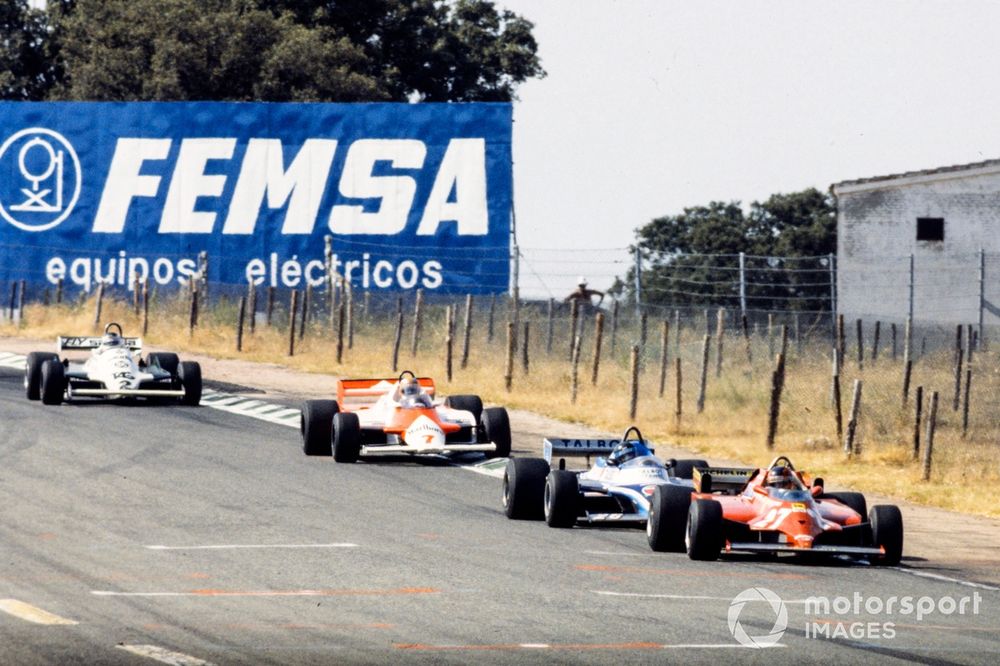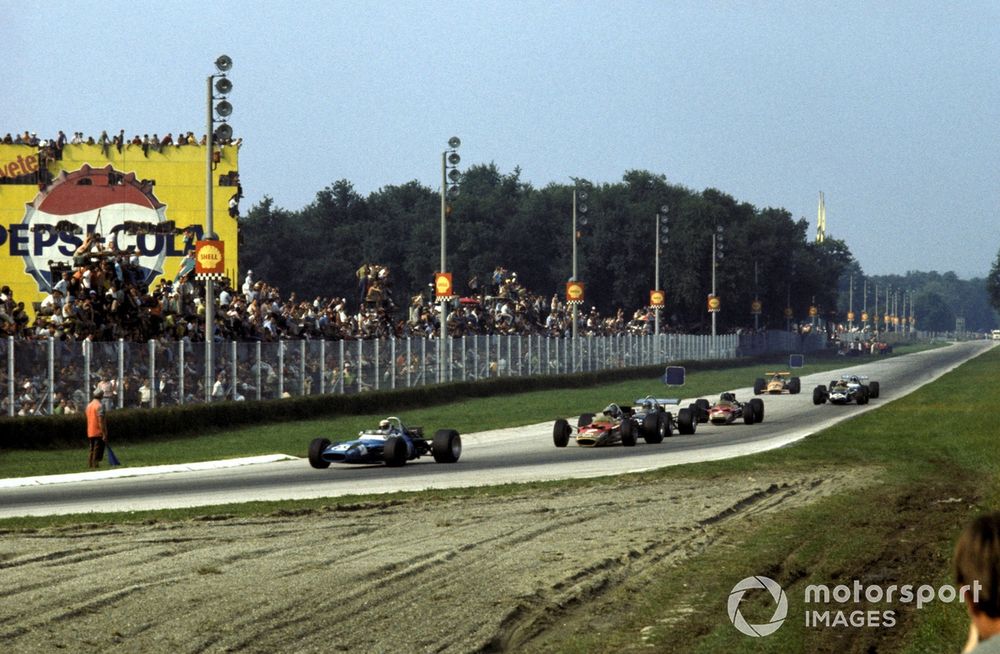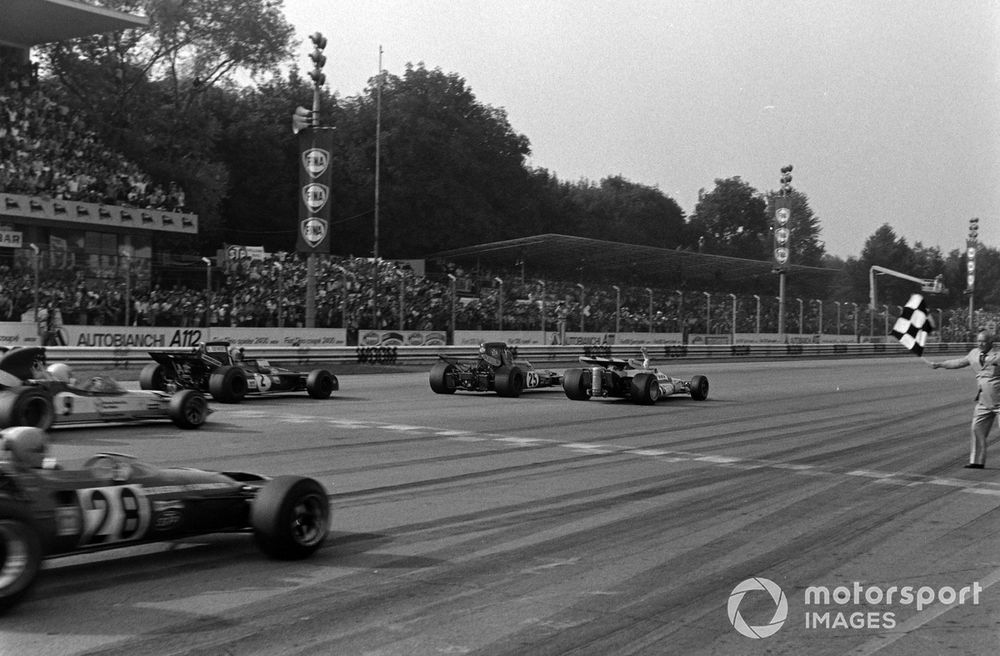There have been several close finishes in Formula 1 history involving two cars racing, or as was the case for Ferrari at the 2002 US Grand Prix, putting on a display of ‘racing’ towards the line. The margin of victory for Rubens Barrichello that day, on a botched attempt at creating a dead heat, was just 0.011s in favour of the Brazilian over team-mate Michael Schumacher.
But occasions when the leading three cars are line astern at the finish are altogether rarer. George Russell’s on-the-road win at Spa, later handed to Mercedes team-mate Lewis Hamilton after his car was found to be underweight, was all the more spectacular as Oscar Piastri loomed large in their mirrors.
Here we look over a few instances in F1 history where the top three were even closer still.
5. Monaco GP 2012

Mark Webber, Red Bull RB8 Renault.
Photo by: Rainer W. Schlegelmilch / Motorsport Images
1. Mark Webber, Red Bull
2. Nico Rosberg, Mercedes (+0.643s)
3. Fernando Alonso, Ferrari (+0.947s)
The 2012 Monaco Grand Prix is mostly remembered for Michael Schumacher’s fastest time in qualifying, which to this day would still make him the oldest polesitter since 1970, hadn’t the 43-year-old served a five-place grid penalty for colliding with Bruno Senna in the previous round.
As a consequence, Red Bull’s Mark Webber started in pole position ahead of Mercedes’ Nico Rosberg and McLaren’s Lewis Hamilton, while championship leader Fernando Alonso was fifth and title contender Sebastian Vettel down in ninth.
The safety car neutralised the race early on following multiple first-lap contacts ending the races of three drivers including Romain Grosjean, who had started fourth. Webber still led from Rosberg and Hamilton, with Alonso now up to fourth and Vettel sixth.
On lap 26, Webber held a 1.8s gap on Rosberg, with Hamilton, Alonso and Felipe Massa respectively 6.6s, 7.4s and 9.5s away from the lead.
All of them made their only pitstop in the next five laps, with Vettel electing to stay on track to enjoy the clear track and free air while hoping for a rain shower to make his gamble jackpot-worthy. The reigning double world champion eventually changed tyres on lap 46 and rejoined in fourth, now just only 3.5s off first place, behind leader Webber, Rosberg and Alonso; completed by Hamilton and Massa, the top 6 was covered by 5.3s.
Some scarce drops of rain did materialise at last, around ten laps before the end of the race, but only Jean-Eric Vergne gambled on intermediates, which cost him a likely seventh-place finish.
Meanwhile, the fight for victory and podium became closer than it ever was, but the order didn’t change and Webber took the win from Rosberg and Alonso. Vettel’s fourth meant the top four was covered by 1.343s.
4. Abu Dhabi GP 2016

Lewis Hamilton, Mercedes F1 W07 Hybrid, crosses the line and takes the chequered flag to win the race from Nico Rosberg, Mercedes F1 W07 Hybrid, Sebastian Vettel, Ferrari SF16-H, and Max Verstappen, Red Bull Racing RB12
Photo by: Glenn Dunbar / Motorsport Images
1. Lewis Hamilton, Mercedes
2. Nico Rosberg, Mercedes (+0.439s)
3. Sebastian Vettel, Ferrari (+0.843s)
The stakes were high at the title-deciding 2016 Abu Dhabi Grand Prix, with Mercedes’ Nico Rosberg leading team-mate Lewis Hamilton by 12 points but the Briton grabbing pole position ahead of his rival.
Hamilton kept the lead at the start, with Ferrari’s Kimi Raikkonen passing Red Bull’s Daniel Ricciardo for third. Then a three-time world champion, Hamilton knew winning was not enough: he needed Rosberg to finish fourth at best to claim the title.
Hamilton managed to pull a 5.6s gap on Rosberg by lap 20 as the German was stuck behind Max Verstappen’s Red Bull for some time after his first pitstop, but Rosberg remained a comfortable second, so Hamilton decided to lose a few tenths a lap in order to back his team-mate into the pack.
As a consequence, at the end of lap 49 of 55, Rosberg was 0.9s off Hamilton while leading Verstappen by 1.5s and Vettel by 2.1s. The Ferrari driver had much fresher tyres and quickly overtook the Red Bull for third.
Though Mercedes was urging him to pick up the pace, Hamilton slowed down more dramatically at the end of the race, going from 1m45.9s on lap 53 to 1.46.3s and finally 1.47.2s, but it did not suffice for the title.
The Englishman took the chequered flag four tenths ahead of Rosberg, leading Vettel by eight, while Verstappen was a further eight tenths back. Rosberg won his single world championship and announced his retirement from Formula 1 just five days later.
3. Spanish GP 1981

Villeneuve’s sixth and last GP win came under huge pressure
Photo by: LAT Photographic
1. Gilles Villeneuve, Ferrari
2. Jacques Laffite, Ligier (+0.211s)
3. John Watson, McLaren (+0.571s)
Jacques Laffite may have been only fifth in the drivers’ standings coming into the 1981 Spanish Grand Prix, but he achieved the seventh and last pole position of his career on the twisty Jarama track, with both Williams right behind him – driven by Alan Jones and championship leader Carlos Reutemann.
Due to the late June heat, the race took place at 4pm. Laffite got a dismal getaway and dropped to 11th, with Jones and Reutemann taking the lead while Ferrari’s Gilles Villeneuve jumped from seventh to third before overtaking Reutemann on the next lap.
Jones was in a class of his own and was 10.4s clear of Villeneuve after 13 laps, but the reigning world champion then went off, losing 15 places and nearly 55 seconds in the process.
New leader Villeneuve had a fast car on straights but slow in corners, with Reutemann closely tucked behind the Ferrari but unable to make a move. Now in third, Renault’s Alain Prost brought the gap down from 9.6s to 3.9s in 14 laps, but he misjudged a braking point, went off and had to retire.
At that stage, Villeneuve and Reutemann led John Watson and Laffite by over 12 seconds, with the Frenchman having fought his way back into the top five and overtaking the McLaren driver on lap 49.
Laffite caught up with the leaders on lap 60 and was swift to overtake Reutemann, who dropped to fourth behind Watson. Villeneuve’s Ferrari was unassailable, and the Quebecois took his sixth and last grand prix win from Laffite, Watson, Reutemann and Lotus’ Elio de Angelis: five different constructors in a top five covered by 1.24s.
2. Italian GP 1969

Jackie Stewart, Matra MS80
Photo by: David Phipps
1. Jackie Stewart, Matra
2. Jochen Rindt, Lotus (+0.08s)
3. Jean-Pierre Beltoise, Matra (+0.17s)
Once upon a time, Monza was a track bereft of any chicanes. Just imagine what the temple of speed was like back then, because it really explains why the Italian circuit bags the first two positions here.
The 1969 Italian Grand Prix took place with little suspense remaining in the title race, as Matra’s Jackie Stewart led the way with 51 points – more than twice his closest challenger Jacky Ickx’s 22, with four rounds to go. Stewart had a first opportunity for a maiden crown that weekend in Lombardy.
The Scot was only third on the grid, outqualified by Lotus’s Jochen Rindt and McLaren’s Denny Hulme. Yet, he made his way to the front as early as the first lap, but was not able to pull away.
The slipstream phenomenon, which was much stronger than at any other track, meant that the lead changed hands 15 times in the first 38 laps – the order being recorded at the end of each lap only, so there may have been more switches – with Stewart, Rindt, Hulme and Piers Courage trading first place.
Further on, Stewart mostly kept the lead while Hulme was out of contention due to brake issues, but the Matra driver was still followed closely by another five cars: team-mate Jean-Pierre Beltoise, the Lotuses of Rindt and Graham Hill, Courage’s Brabham and Bruce McLaren driving his own machinery. Stewart would sometimes let Rindt or Hill into the lead in the Lesmos before repassing them on the next straight.
Hill kept pressuring Stewart ahead of third-placed Courage, but the latter’s Brabham suffered a fuel system issue and dropped out of contention. Then Hill retired due to a driveshaft failure on his Lotus, leaving Stewart with just four rivals.
Rindt took the lead again in the Lesmos on the last lap, but Stewart was back in front by what is now known as Variante Ascari, which was then just a kink. Beltoise dived down the inside of the last corner, Parabolica, but ran wide and hindered Rindt. Stewart managed to cross the finish line both a winner and a world champion, leading these two and McLaren… all four covered by fewer than two tenths of a second.
1. Italian GP 1971

Peter Gethin, BRM P160 beats Ronnie Peterson, March 711 Ford across the finish line in the closest finish in an F1 race at 0.01 seconds.
Photo by: LAT Photographic
1. Peter Gethin, BRM
2. Ronnie Peterson, March (+0.01s)
3. Francois Cevert, Tyrrell (+0.09s)
This time around, Tyrrell’s Stewart was already the world champion coming into the Monza round, having been crowned in the preceding race at Osterreichring – an older version of Red Bull Ring.
Matra’s Chris Amon took pole with a remarkable 1m22.40s – over 251km/h on average thanks to the slipstream – ahead of Ickx on Ferrari, followed by BRM’s Siffert and Howden Ganley.
Sunday’s race was even more frantic than two years prior, with at least eight different race leaders – among whom Ferrari’s Clay Regazzoni and Stewart would be struck by engine failures on a hot afternoon, while Siffert would get stuck in fourth gear.
Ten laps before the end of the race, Amon was in the lead, but the New Zealander mistakenly removed his two visors instead of just the dirty one and had to slow down.
It was now a five-way fight involving Peterson, Cevert, Ganley, Mike Hailwood on Surtees, and Peter Gethin, who had started just 11th but had fought his way to the front of the pack. Incredibly, all five of them were yet to win a grand prix.
Gethin took the lead for the first time on lap 52 of 55, before being repassed two tours later by Peterson, who led from Cevert, Hailwood, Gethin and Ganley when starting the last 5.75km of the Monza track.
Cevert had taken the lead before the last corner, where Peterson overtook him on braking, but Gethin had a better exit and went on to win by a hundredth of a second, with the top five covered by 0.061s. This was the last we saw of the chicane-free Monza.








